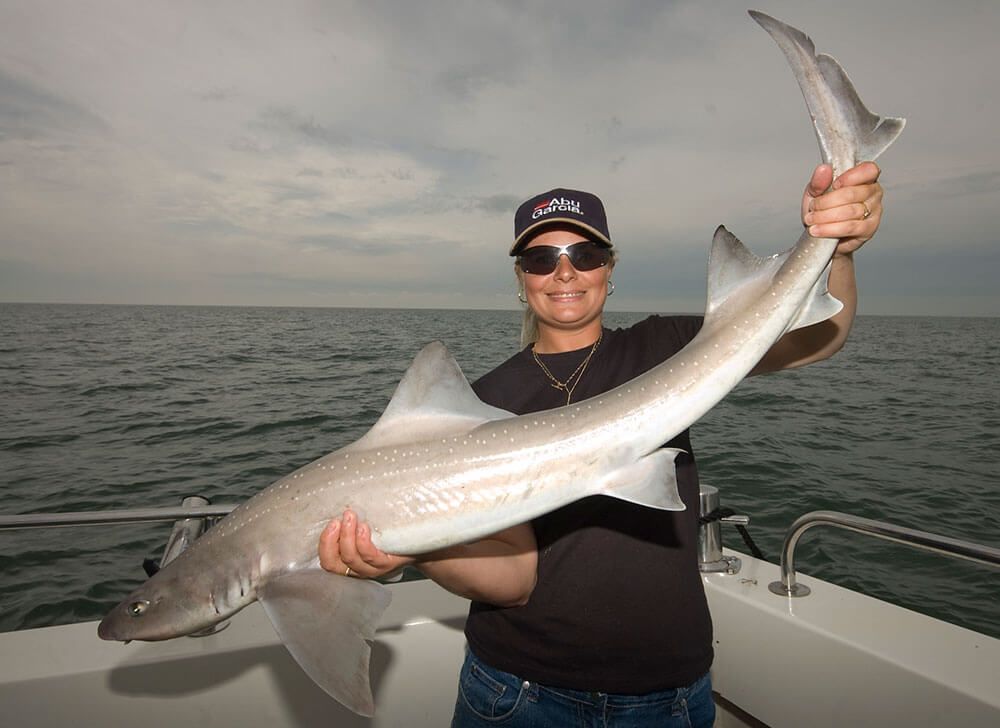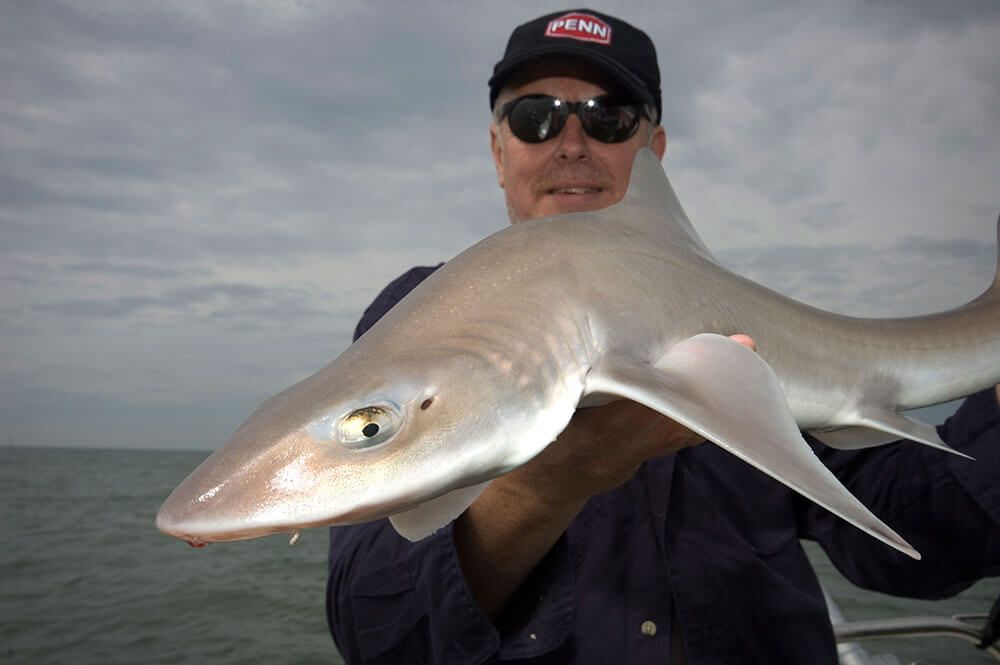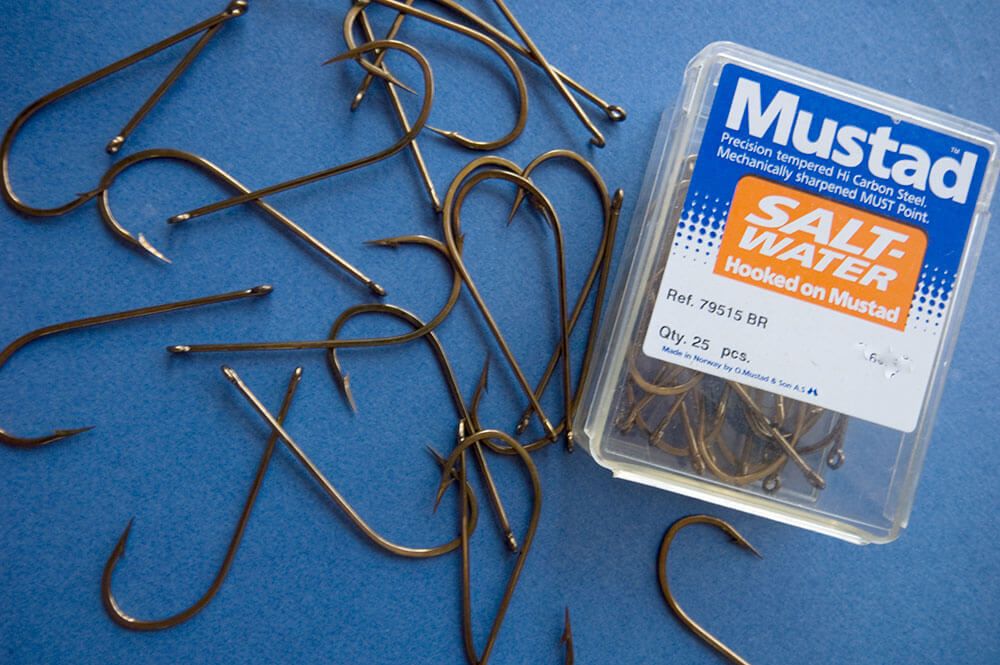There are, though there has been some debate about this recently, two types of smoothhound, the common and starry smoothhound. But given the differences in the two fish as outlined below, most anglers feel that the two types are distinctive.
To identify common smoothhound from starry smoothhound check the nasal flaps which on the common smoothhound are broad and the dermal denticles on the skin are narrow with basal ridges but smooth ends, also the body has no markings. The starry smoothhound has narrower nasal flaps and broader dermal denticles, plus usually has small white star type markings scattered across the body flanks, though sometimes these can be missing so are not to be relied upon as absolute identification. General colouration of both species is a grey back shading to a grey/white belly.
Smoothhound can only really be confused with tope. The key difference to note is that the smoothhound have flat, broad grinding teeth, but the tope’s teeth are triangular in shape and sharply pointed. The tope’s lower tail lobe is also long, whereas the smoothhounds is short and blunt.
Both types of smoothhound are shallow water fish tending to be found relatively close in shore and along the surf line, but they can be found down to about 70-metres. They feed on shore crabs, hermit crabs and edible crabs, also squat lobsters, sea anemones, but will also take worms such as lug and rag.

Another key factor separating the two types of smoothhound is that the common smoothhound is viviparous, meaning the young are nourished from a pseudoplacenta formed by the yolk-sac membrane connected to the mother. They give birth to up to 15 young which can measure up to 12-inches in length. The starry smoothhound is ovoviviparous with the young developed within the mother by a yolk-sac but with no membrane connection to the mother. They give birth to between 7 and 15 babies, the number depending on the overall size of the mother.
The breeding season is somewhat unknown, but appears to fall in to the period January to April
It’s interesting to note that the common smoothhound are actually less common in numbers in UK waters than the starry smoothhound are. Also the two distinct types will often be swimming and feeding together.
WHEN AND WHERE TO FISH
Both common and starry smoothhound can be found all round the UK coast, though the commons are more southerly based and tend to venture only as far north as southern Scotland. The starry smoothhound has been recorded as far north as southern Norway. To the south they can be found down in to the Mediterranean and off the North African coast.
Noted areas in the UK for top smoothhound fishing are the East Coast as high as The Wash, the Thames Estuary, The Hampshire coast, both sides of the Bristol Channel, Anglesey’s northwest corner and Luce Bay in Scotland.
Smoothhound can be found over sand banks and sandy gutters, in amongst mixed rough ground scattered amongst sand, they especially favour eel grass beds, also shingle banks and any areas where big boulders break up general low even contoured rough ground.
Smoothhound are mostly caught in daylight and much less frequently at night. They have a habit of being on ground for just a few tides, then disappearing. What’s happening here is that with smoothhound being a group fish they can clean out the food supply in a given area over two or three tides, then need to move on to fresh ground.
The middle sized rising tides to the highest spring tides will invariably produce the best fishing. They like some tide run and the key time of tide can often be the middle two hours when the run is strongest, though just after low water on some marks can be equally good.

Books and features on smoothhound often depict them as preferring mirror calm sea conditions, and they can be caught when the weather is calm, but they are built to swim effectively feeding on the seabed, so a good sea swell in shallow inshore water can often lead to good catches, especially in a calming sea after a spell of windy weather with coloured seas.
TACKLE FOR SMOOTHHOUND
Uptide rods were once the main weapon in the smoothhound angler’s armoury, but these remain popular now only in The Wash area, The Thames Estuary and inside the Bristol Channel. Rods of 9ft 6in to 10ft and rated 2-6ozs are ideal and you can match them to reels in the ABU 6500, Penn 525 or Daiwa 7HT sizing loaded with 15lb line and a 40lb shock leader. Only on the biggest tides when very heavy leads are needed to hold down would the heavier 6-10oz rated uptiders be used as these over gun even the biggest smoothhounds.
In other areas where tide run is less harsh, most experienced smoothhound anglers will opt for an 8lb to 15lb class rod about 8ft to 8ft 6ins, and again match them to the smaller 6500 or 525 sized reels. Alternatively load a 050/060 sized fixed spool with 20lb braid and a 30lb shock leader when fishing lighter leads up to 4ozs for maximum sport.
HOW TO BUILD A BOAT UPTIDE SMOOTHHOUND RIG
BAITS
Squid is a good bait for boat smoothhound, especially a whole body, but makes sure the hook point is positioned in the head other wise then can nip off the head and miss a hook positioned further up inside the body.
Razorfish is a good bait after a rough sea when there is colour in the water. Rag and squid or rag and crab cocktails also work well. Smoothhound will occasionally take fish baits but these are less reliable than crab, squid and rag.
HOW TO PREPARE SHORE CRAB FOR SMOOTHHOUND
TOP TIP 1
To reduce the effect of tide drag on the line many anglers now use braided main line which is much thinner in diameter for the same breaking strain than mono line is therefore reducing the effect of drag. Braid also allows a lighter lead weight to be used and still hold bottom, plus it’s also more responsive and will show shy bites better.
However, because braid does not stretch, it pays to use a mono shock leader about twice the length of the rod to absorb casting pressures, but also to give a little stretch when fighting fish to preserve a good kook hold and to give stretch when a big fish is up near the boat on the surface and all its weight is on a short length of line.
TOP TIP 2
Smoothhound bites show usually as a series of slight knocks, followed by slack line as the fish takes the bait and turns back with the tide run pulling the lead weight free. Wind in the slack line until the weight of the fish is felt then set the hook with an upward strike.
The fight is a series of fast runs and dogged resistance, but bigger fish will hug the bottom then go off on a long blistering run, then stay deep again, only showing on the surface right behind the boat as they fully tire.
TOP TIP 3
Smoothhound have tough mouths so make sure you use a honing stone or hook file on none chemically sharpened hook points to make sure they are ultra sharp to gain a good hook hold on the strike.
Knife edge patterns such as the Mustad Viking 79515 can be honed to an ultra sharp cutting edge and are a popular pattern. Alternatively look at the Sakuma 540 Manta which is chemically sharpened with a wide gape, but strong.

TOP TIP 4
A good tip when fishing amongst sandbanks in a light to medium tide run, but only when fishing off the stern of the boat, is to cast a plain lead well out and slightly uptide and beyond the other anglers. Let the lead swing round with the tide until it comes to a stop at the base of a sandbank. Smoothhound like to work along the base of sandbanks as food washed in by the tide will locate here.
TOP TIP 5
When uptide casting don’t just keep casting to the same distance and same spot. Use what arc you have to explore the ground yard by yard, dropping short and casting longer to cover all the ground in front of you. This can identify tiny little areas of rough ground or depressions that seem to produce most even all of your bites. This will be a spot where water borne food gets washed in to by the tide and fish repeatedly visit it.
To identify common smoothhound from starry smoothhound check the nasal flaps which on the common smoothhound are broad and the dermal denticles on the skin are narrow with basal ridges but smooth ends, also the body has no markings. The starry smoothhound has narrower nasal flaps and broader dermal denticles, plus usually has small white star type markings scattered across the body flanks, though sometimes these can be missing so are not to be relied upon as absolute identification. General colouration of both species is a grey back shading to a grey/white belly.
Smoothhound can only really be confused with tope. The key difference to note is that the smoothhound have flat, broad grinding teeth, but the tope’s teeth are triangular in shape and sharply pointed. The tope’s lower tail lobe is also long, whereas the smoothhounds is short and blunt.
Both types of smoothhound are shallow water fish tending to be found relatively close in shore and along the surf line, but they can be found down to about 70-metres. They feed on shore crabs, hermit crabs and edible crabs, also squat lobsters, sea anemones, but will also take worms such as lug and rag.

Another key factor separating the two types of smoothhound is that the common smoothhound is viviparous, meaning the young are nourished from a pseudoplacenta formed by the yolk-sac membrane connected to the mother. They give birth to up to 15 young which can measure up to 12-inches in length. The starry smoothhound is ovoviviparous with the young developed within the mother by a yolk-sac but with no membrane connection to the mother. They give birth to between 7 and 15 babies, the number depending on the overall size of the mother.
The breeding season is somewhat unknown, but appears to fall in to the period January to April
It’s interesting to note that the common smoothhound are actually less common in numbers in UK waters than the starry smoothhound are. Also the two distinct types will often be swimming and feeding together.
WHEN AND WHERE TO FISH
Both common and starry smoothhound can be found all round the UK coast, though the commons are more southerly based and tend to venture only as far north as southern Scotland. The starry smoothhound has been recorded as far north as southern Norway. To the south they can be found down in to the Mediterranean and off the North African coast.
Noted areas in the UK for top smoothhound fishing are the East Coast as high as The Wash, the Thames Estuary, The Hampshire coast, both sides of the Bristol Channel, Anglesey’s northwest corner and Luce Bay in Scotland.
Smoothhound can be found over sand banks and sandy gutters, in amongst mixed rough ground scattered amongst sand, they especially favour eel grass beds, also shingle banks and any areas where big boulders break up general low even contoured rough ground.
Smoothhound are mostly caught in daylight and much less frequently at night. They have a habit of being on ground for just a few tides, then disappearing. What’s happening here is that with smoothhound being a group fish they can clean out the food supply in a given area over two or three tides, then need to move on to fresh ground.
The middle sized rising tides to the highest spring tides will invariably produce the best fishing. They like some tide run and the key time of tide can often be the middle two hours when the run is strongest, though just after low water on some marks can be equally good.

Books and features on smoothhound often depict them as preferring mirror calm sea conditions, and they can be caught when the weather is calm, but they are built to swim effectively feeding on the seabed, so a good sea swell in shallow inshore water can often lead to good catches, especially in a calming sea after a spell of windy weather with coloured seas.
TACKLE FOR SMOOTHHOUND
Uptide rods were once the main weapon in the smoothhound angler’s armoury, but these remain popular now only in The Wash area, The Thames Estuary and inside the Bristol Channel. Rods of 9ft 6in to 10ft and rated 2-6ozs are ideal and you can match them to reels in the ABU 6500, Penn 525 or Daiwa 7HT sizing loaded with 15lb line and a 40lb shock leader. Only on the biggest tides when very heavy leads are needed to hold down would the heavier 6-10oz rated uptiders be used as these over gun even the biggest smoothhounds.
In other areas where tide run is less harsh, most experienced smoothhound anglers will opt for an 8lb to 15lb class rod about 8ft to 8ft 6ins, and again match them to the smaller 6500 or 525 sized reels. Alternatively load a 050/060 sized fixed spool with 20lb braid and a 30lb shock leader when fishing lighter leads up to 4ozs for maximum sport.
HOW TO BUILD A BOAT UPTIDE SMOOTHHOUND RIG
BAITS
Squid is a good bait for boat smoothhound, especially a whole body, but makes sure the hook point is positioned in the head other wise then can nip off the head and miss a hook positioned further up inside the body.
Razorfish is a good bait after a rough sea when there is colour in the water. Rag and squid or rag and crab cocktails also work well. Smoothhound will occasionally take fish baits but these are less reliable than crab, squid and rag.
HOW TO PREPARE SHORE CRAB FOR SMOOTHHOUND
TOP TIP 1
To reduce the effect of tide drag on the line many anglers now use braided main line which is much thinner in diameter for the same breaking strain than mono line is therefore reducing the effect of drag. Braid also allows a lighter lead weight to be used and still hold bottom, plus it’s also more responsive and will show shy bites better.
However, because braid does not stretch, it pays to use a mono shock leader about twice the length of the rod to absorb casting pressures, but also to give a little stretch when fighting fish to preserve a good kook hold and to give stretch when a big fish is up near the boat on the surface and all its weight is on a short length of line.
TOP TIP 2
Smoothhound bites show usually as a series of slight knocks, followed by slack line as the fish takes the bait and turns back with the tide run pulling the lead weight free. Wind in the slack line until the weight of the fish is felt then set the hook with an upward strike.
The fight is a series of fast runs and dogged resistance, but bigger fish will hug the bottom then go off on a long blistering run, then stay deep again, only showing on the surface right behind the boat as they fully tire.
TOP TIP 3
Smoothhound have tough mouths so make sure you use a honing stone or hook file on none chemically sharpened hook points to make sure they are ultra sharp to gain a good hook hold on the strike.
Knife edge patterns such as the Mustad Viking 79515 can be honed to an ultra sharp cutting edge and are a popular pattern. Alternatively look at the Sakuma 540 Manta which is chemically sharpened with a wide gape, but strong.

TOP TIP 4
A good tip when fishing amongst sandbanks in a light to medium tide run, but only when fishing off the stern of the boat, is to cast a plain lead well out and slightly uptide and beyond the other anglers. Let the lead swing round with the tide until it comes to a stop at the base of a sandbank. Smoothhound like to work along the base of sandbanks as food washed in by the tide will locate here.
TOP TIP 5
When uptide casting don’t just keep casting to the same distance and same spot. Use what arc you have to explore the ground yard by yard, dropping short and casting longer to cover all the ground in front of you. This can identify tiny little areas of rough ground or depressions that seem to produce most even all of your bites. This will be a spot where water borne food gets washed in to by the tide and fish repeatedly visit it.

